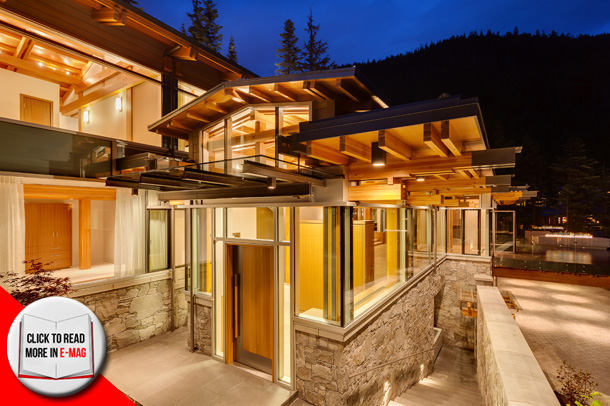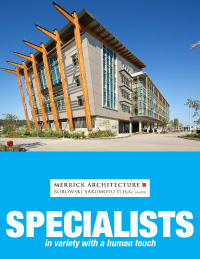Specialists in variety with a human touch
By: Mudeeha Yousaf
The practice of building and sustaining viable works of architecture that stand the test of time is at the foundation of Merrick Architecture – a multidisciplinary firmthat promotes a humanizing approach throughout their design process while fostering a culture of creativity. With British Columbia as the practice’s playground, Merrick Architecture believes the history of a site and its context can help shape its future, and it is with this ideal that the firm drives the practice of architectureforward.
HISTORY
Founded as a design-based firm in 1984 by Paul Merrick, the company celebrates 30 years of delivering a wide range and scale of projects that are holistic and unique. In 2004 the company expanded the ownership of the practice and under the leadership of current Principals Gregory Borowski, Mitch Sakumoto and Graham Fligg, the firm has sustained and consolidated the award-winning position it holds today.
We had a chance to chat with the partners about their growing success and the drive behind it. “When I joined the practice I wanted to achieve projects that conveyed a sense of human value combined with quality and substance. 25 years later I believethe practice has stayed true to its roots. We’re unique on many levels, and we understand the corporate world on a global level, but the criteria that we fundamentally share is that it is people that drive the world, not a big corporate machine,” says Fligg, when asked what differentiates their practice from the rest. “We see ourselves leading a relatively efficient level of staffing, yet offering strong enough expertise and leadership to be able to take on significant projects, but at the same time providing a personalized level of service.” The Principals share a common philosophy which marries efficiency in execution with a humanizing approach to business, while ensuring that every project is assigned a designated Principal so that the client is able to access senior experience through each step of the process. This ‘boutique brand’ approach epitomizes the human basis of the practice, ensures quality control, and nurtures comradely.
SIGNIFICANT PROJECTS
Though a mid-sized firm, the company’s project portfolio consists of a variety of prominent projects, and “we can accomplish more large-scale projects than our size might suggest,” says Fligg. “We believe this is because of our commitment to quality time and a high degree of client interaction in the conceptual phase.” The company’s breadth of experience stems from working on projects of varying sizes, different scopes and across many locations, and Merrick’s resulting portfolio is comprised of commercial, residential and mixed use projects, as well as significant buildings in the education and healthcare sectors. “We are grateful to maintain a reputation that is humanity based. Our projects have a sense of soul in them and we frequently receive positive feedback about the aesthetics and the feeling one gets through our projects.” One project that put Merrick on the map was Cathedral Place, an award-winning office tower in downtown Vancouver that received recognition through its distinctive aestheticand high quality detail. The project solidified the practice’s reputation and critics and clients took note that Merrick had the capacity to produce buildings, urban spaces and unique environments that challenged the norm. “It’s about communication with your clients, rolling up your sleeves and reflecting on what approach is going to maximize one’s goal. This is high on our radar in working through solutions.”
A practice that the company holds dear is the restoration and adaptive reuse of older buildings. This was the case when Merrick took on City Square, a commercial project early in the history of the practice which salvaged and embraced two heritage school buildings to create a transformative shopping centre composition, a project that ultimately led Merrick into incorporating heritage components into many oftheir buildings thereafter. The centre created a significant “people place” and produced a vibrant environment instead of an artificially ventilated space. “These projects were significant in Vancouver at the time because we have buildings that are worth readapting and not simply bulldozing. We were among the firms that pioneered reusing building structures for different purposes,” says Borowski. “We’re specialists in variety and our range of projects speaks to that.”
A habitual practice in western Canada is to tear down buildings whose history predates 30 years, though Merrick believes that one pillar of sustainability is financial responsibility, and the practice strives to deliver substance and quality design that will last more than a few decades. As an example of repurposing existing building fabric, The Downtown Single Residential Occupancy (SRO) Renewal Initiative for B.C. Housing and the provincial government aims to renew and restore 13 SRO hotels located in Vancouver’s Downtown Eastside, and is expected to produce numerous benefits to otherwise disenfranchisedresidents. Merrick proudly partakes in this substantial and socially responsible initiative. “We like to take on projects that have a certain cultural value. We see the built environment as a very valuable commodity and believe it should be an evolutionary and adaptable asset,” says Fligg.
SUSTAINABLE DESIGN
Another feat for the company came when they led the consulting team on the creation of Vancouver’s Olympic Village, which accomplished a LEED Platinum Neighbourhood rating for its sustainable design practices. The project took on Passive solar design which makes use of the sun’s energy for the heating and cooling of living spaces, as well as a high-performanceBuilding Envelope design plus an energy efficient radiantheating and cooling system. The $1 billon project was a benchmark for sustainable design in North America, and Merrick was responsible for the overall coordination and spearheaded the design of 3 out of the 10 Village building parcels. Merrick commits to providing solutions that offer delight and comfort, while aiming to reduce energy. LEED is more than ever being entrenched in the construction world, as well as the company’s, and remains a mechanism for third party review and the formalizing of sustainable design practices. “We approach all projects with a goal to produce responsible longevity. We preached sustainability long before it was a common industry word and many of our projects use or reference LEED criteria,” comments Fligg.
CREATIVITY AND STANDARDS
Architectural practice is experiencing a rapid increase of regulations which govern almost every aspect of a project beyond the traditional role of the architect as a master coordinator. Very few involved have the capacity to filter and manage the exponential expansion of regulations. The challenge arises when a project’s potential is limited through an overly-intensive regulatory framework, and Merrick endeavors to work with their clients and sub consultants to maintain the correct balance of creativity and standards. “Many regulations, theoretically, lead to better buildings and are therefore supportable in principle, but maintaining familiarity with them and deciphering which apply is becoming all-consuming for design professionals, sometimes to the detriment of creativity.”
As well, “the delivery of projects through the P3 process is an increasingly favoured method of project realization, especially within the institutional and public sector. This reduces financial risk for owners, though the method can dilute the impartial control that architects once were able to extend. Decisions are sometimes based on short term expenditure rather than on the basis of long term benefit for the end user. One could postulate that it can become a process of a delayed transfer of risk.”
To counterbalance the challenges thrown their way by the industry, the firm uses the latest in technologies to ensure efficiency. Merrick has utilized computers in production of their drawings for 25 years and was an early advocate of this approach with regard to technical documentation. However, they hold traditional hand sketching as an essential exploratory tool that is invaluable to the creative process. “As demands increase for Building Information Management systems, we are keeping abreast of industry trends by the upgrade of work stations to include the Revit program, yet this and other systems are only as effective as the people who use them. A major challenge is balancing the employ of technologies available so that a good balance of artful inspiration and technical expertise is maintained, with neither dominating the other.”
TECHNICAL EXCELLENCE
If a slew of successful projects and an overall contribution to British Columbia’s cultural landscape weren’t enough, the architectural firm also enjoys and celebrates the acclamations and recognitions garnered over three decades. The Royal Architectural Institute of Canada Award for Outstanding Architectural Practice, the VRCA Silver Award for 2013, B.C. Wood Design Award and the B.C. Heritage Award of Honour are just a few on the list. “Architecture is a renaissance profession, and we try to remind our clients of the totality of what we’re creating. It’s a marriage of art and science. Our paramount goal is to satisfy our clients and end users, and their delight is the best testimony to our accomplishments. The reward comes from a client being happy with the result,” says Borowski.
Presently, Merrick Architecture wishes to further their practice through building on their identity as a boutique practice while strengthening and enhancing the reputation they have constructed. “Imagination, creativity, technical excellence – these are values we hold highly and as long as we stand by these, our practice will thrive.”
For more information on Merrick Architecture, visit www.merrickarch.com







